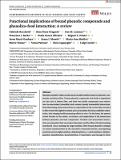Por favor, use este identificador para citar o enlazar a este item:
http://hdl.handle.net/10261/283743COMPARTIR / EXPORTAR:
 SHARE
BASE SHARE
BASE
|
|
| Visualizar otros formatos: MARC | Dublin Core | RDF | ORE | MODS | METS | DIDL | DATACITE | |

| Título: | Functional implications of bound phenolic compounds and phenolics-food interaction: A review |
Autor: | Rocchetti, Gabriele; Perez Gregorio, Rosa; Lorenzo, José M.; Barba, Francisco J. CSIC ORCID; García Oliveira, Paula; Prieto, Miguel Ángel CSIC ORCID; Simal Gandara, Jesús; Mosele, Juana I.; Motilva, María-José CSIC ORCID ; Tomas, Merve; Patrone, Vania; Capanoglu, Esra; Lucini, Luigi | Palabras clave: | Bioaccessibility, Bound phenolics, Gut, Microbial transformations, Microbiota | Fecha de publicación: | mar-2022 | Editor: | John Wiley & Sons Institute of Food Technologists |
Citación: | Comprehensive Reviews in Food Science and Food Safety 21(2): 811-842 (2022) | Resumen: | Sizeable scientific evidence indicates the health benefits related to phenolic compounds and dietary fiber. Various phenolic compounds-rich foods or ingredients are also rich in dietary fiber, and these two health components may interrelate via noncovalent (reversible) and covalent (mostly irreversible) interactions. Notwithstanding, these interactions are responsible for the carrier effect ascribed to fiber toward the digestive systemand canmodulate the bioaccessibility of phenolics, thus shaping health-promoting effects in vivo. On this basis, the present review focuses on the nature, occurrence, and implications of the interactions between phenolics and food components. Covalent and noncovalent interactions are presented, their occurrence discussed, and the effect of food processing introduced. Once reaching the large intestine, fiber-bound phenolics undergo an intense transformation by the microbial community therein, encompassing reactions such as deglycosylation, dehydroxylation, ¿- and ß-oxidation, dehydrogenation, demethylation, decarboxylation, C-ring fission, and cleavage to lower molecular weight phenolics. Comparatively less information is still available on the consequences on gut microbiota. So far, the very most of the information on the ability of bound phenolics tomodulate gut microbiota relates to in vitro models and single strains in culture medium.Despite offering promising information, such models provide limited information about the effect on gut microbes, and future research is deemed in this field. | Versión del editor: | http://dx.doi.org/10.1111/1541-4337.12921 | URI: | http://hdl.handle.net/10261/283743 | DOI: | 10.1111/1541-4337.12921 | Identificadores: | doi: 10.1111/1541-4337.12921 issn: 1541-4337 |
| Aparece en las colecciones: | (ICVV) Artículos |
Ficheros en este ítem:
| Fichero | Descripción | Tamaño | Formato | |
|---|---|---|---|---|
| Comp Rev Food Sci Food Safe - 2022 - Rocchetti - Functional implications of bound phenolic compounds and phenolics food.pdf | 1,01 MB | Adobe PDF |  Visualizar/Abrir |
CORE Recommender
WEB OF SCIENCETM
Citations
19
checked on 26-mar-2023
Page view(s)
39
checked on 27-abr-2024
Download(s)
70
checked on 27-abr-2024
Google ScholarTM
Check
Altmetric
Altmetric
Este item está licenciado bajo una Licencia Creative Commons

